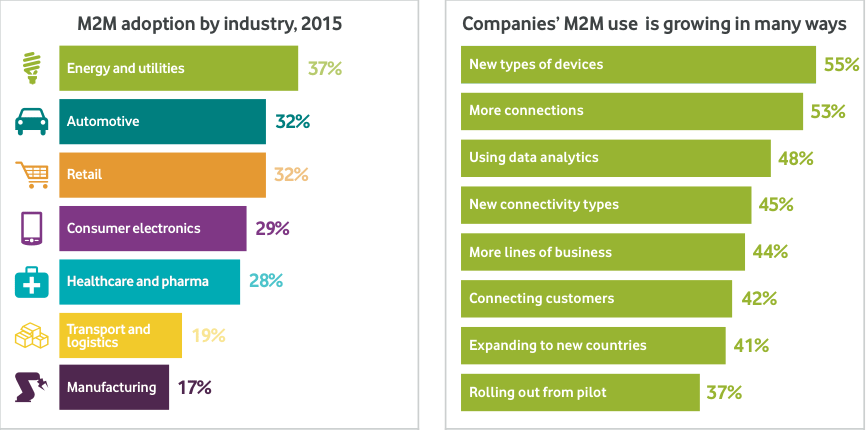Vodafone recently released its third annual M2M Barometer report, developed in conjunction with Circle Research to better understand how businesses are utilizing machine-to-machine and “Internet of Things” technology. In order to get at these answers, 650 business and IT executives around the world were surveyed. In addition, Analysys Mason shared its industry expertise and insights.
Circle Research said it interviewed more than 650 executives from 16 countries and seven industries. The countries represented in the report are the United States, Brazil, Germany, Italy, the Netherlands, Spain, the United Kingdom, Turkey, Australia, India, Japan, South Korea, China, South Africa, Canada and New Zealand. In summary, the survey covered a spread of 30% Americas, 34% EMEA and 36% APAC. Small, medium and large enterprises with national, regional and international operations with a range of 100 to 100,000 employees were included. Interview participants were decision makers in their respective organizations and focused in the areas of IT, research and development, finance, strategy and planning.
Key areas of focus within the study include:
- How rates of adoption are changing across regions, sectors and sizes of business.
- The results that adopters of M2M are seeing in their businesses.
- What early adopters do after launch to extend and evolve their M2M projects.
- How different departments and executives get involved in M2M project decisions.
The first bit of good news is that awareness and adoption are growing since last year’s Barometer survey as seen in the visual presented below.  Recognition of IoT terminology was in last place behind M2M and telematics in the 2014 report, but in 2015 has surpassed both. M2M has also increased year-over-year with a perception that, at least within Europe, it could be driven by “Industry 4.0” initiatives to drive more utilization of the technologies in order to increase productivity and collaboration. It’s also important to note how M2M was defined for the purpose of the interviews – M2M connects, machines, devices and objects to the Internet, turning them into intelligent assets that can “communicate.” M2M was positioned as enabling IoT.
Recognition of IoT terminology was in last place behind M2M and telematics in the 2014 report, but in 2015 has surpassed both. M2M has also increased year-over-year with a perception that, at least within Europe, it could be driven by “Industry 4.0” initiatives to drive more utilization of the technologies in order to increase productivity and collaboration. It’s also important to note how M2M was defined for the purpose of the interviews – M2M connects, machines, devices and objects to the Internet, turning them into intelligent assets that can “communicate.” M2M was positioned as enabling IoT.  One chart that was extremely interesting to me is the one shown below. For all of the discussion of IoT and M2M in the U.S., it seems the Americas are the laggards of the three regions in growth and adoption. Europe shows the highest year-over-year growth, while Africa/Middle East/APAC shows the highest percentage of adoption. Within Europe, the German market is leading the way likely due to the large presence of automotive OEMs and Industry 4.0 initiatives.
One chart that was extremely interesting to me is the one shown below. For all of the discussion of IoT and M2M in the U.S., it seems the Americas are the laggards of the three regions in growth and adoption. Europe shows the highest year-over-year growth, while Africa/Middle East/APAC shows the highest percentage of adoption. Within Europe, the German market is leading the way likely due to the large presence of automotive OEMs and Industry 4.0 initiatives. 
The study found that 50% of adopters are utilizing M2M to enable new business opportunities or operating models. The research shows that the sophistication of these requirements has migrated from one-way data collection to more interactive, high-speed connections. Two-way communications, large amounts of data exchange, extended battery life and extended network reach are all key criteria today.
The overlap of M2M adoption and technology adoption was also noted. The high adopters of M2M also tend to be utilizing big data and cloud solutions. The areas of improvement achieved through the addition of M2M touched on many business aspects. Surprisingly, cost was not in the top three areas of improvement. The top three were productivity, customer service and agility.
Security and privacy are still concerns and potential barriers to adoption, with about one-third of all respondents mentioning those topics. Although the response varied by industry, three quarters of respondents felt M2M had an impact on the security of their network.
The entire report is worth downloading, as I’m only able to touch on a few of the key findings in this shorter format. What’s clear to see is these topics are here to stay. Level of adoption has increased year-over-year along with market awareness. Although there are still concerns with topics such as security and privacy, there are many industry players working to provide solutions. If you’re not already onboard this wave, it seems like the time is right to jump in.
Like what you read? Follow me on twitter!
Claudia Bacco, Managing Director – EMEA for RCR Wireless News, has spent her entire career in telecom, IT and security. Having experience as an operator, software and hardware vendor and as a well-known industry analyst, she has many opinions on the market. She’ll be sharing those opinions along with ongoing trend analysis for RCR Wireless News.

